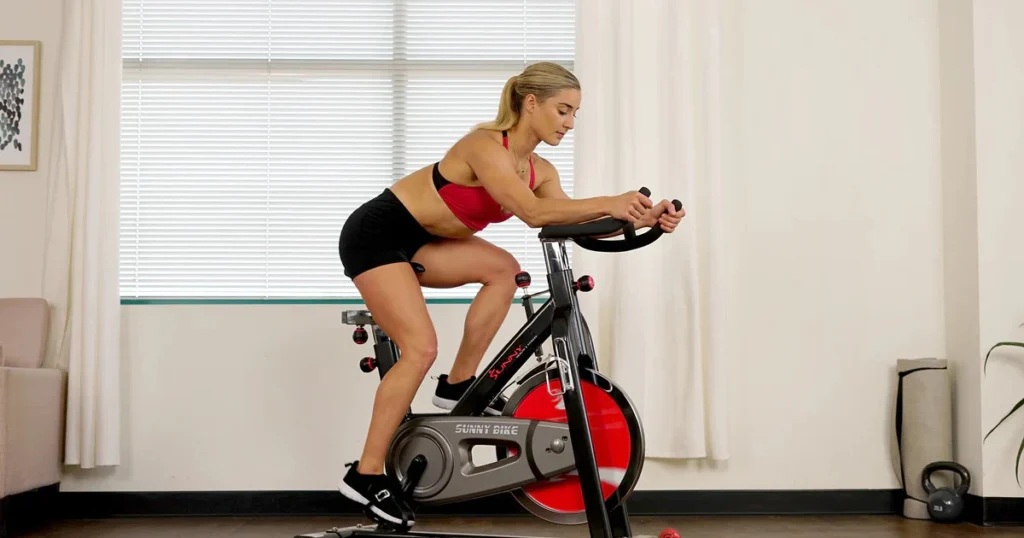Riding a stationary bike is a safe and enjoyable way to get an excellent workout. Since this exercise has gained popularity, many people are curious about the outcomes they can anticipate from using a stationary bike. Stories and images of 1 monthly stationary bike results inspire and motivate new cyclists by revealing their struggles and routines. It’s similar to when a friend undergoes a cycling fitness journey, and everyone else wants to experience it too. Let’s discuss the results of a 1 month exercise bike.
While jumping on the saddle can improve your fitness and health routine, whether you use a Peloton at home, attend a spin session at the gym, or go for a real bike ride. They have many health advantages, and you will see changes later. As with all forms of exercise, it will take time, steadfastness, and commitment to your workout routine to see noticeable changes. According to the general rule, it takes one month to notice your improvement.
Does a Stationary Bike Help in Weight Loss?
Yes, using a stationary bike will help you reduce excess weight. The stationary bike offers a low-impact workout routine, making it an excellent choice for calorie burning and helping with weight loss goals. You’ll soon start to notice that you’re losing weight all over. Your legs and heart will gradually become stronger as you ride a stationary bike. You’ll not only reduce your weight but also put on muscle.
An exercise bike allows you to gradually advance your workouts by allowing you to change the resistance and speed. Raising the resistance can make your workout more difficult, which will help you gain muscle mass and burn more calories within the same time period as a ride with a lower resistance.
Ideal Duration for Stationary Bike Workouts
When embarking on a fitness journey with a stationary exercise bike, understanding the ideal workout duration is crucial, especially when your goal is weight loss. Achieving a calorie deficit, where you burn more calories than you consume, is essential. For example, if your daily maintenance calorie intake is 2000 calories, creating a deficit would mean consuming around 1500–1700 calories.
Calorie Burning Efficiency
- Stationary bikes are highly effective for calorie burning, offering robust aerobic exercise.
- The amount of calories burned varies with factors like age, weight, and intensity.
- A 155-pound individual can burn approximately 252 calories in 30 minutes at moderate intensity and 278 calories at high intensity.
- For a 185-pound person, these numbers increase to 441 calories and 294 calories, respectively, for the same durations.
Setting a Safe Weight Loss Target
- Aim for a healthy weight loss rate of 1-2 pounds per week.
- To lose 1 pound, you need to burn 3,500 calories more than your intake.
- The duration needed to achieve this depends on your weight and the intensity of your cycling workouts.
- For a 125-pound individual, it could take between 5.5 to 8.5 hours of cycling weekly to burn the equivalent of 1 pound of fat.
The time it takes to see tangible weight loss results from using a stationary bike varies for each individual, influenced by starting weight and workout intensity. Regular and consistent cycling, coupled with a balanced diet, is key to achieving and maintaining your weight loss goals.
Also read: How Jogging Can Help You Lose Belly Fat
Before and after Results of 1-month Exercise Bike Challenge
Bicycling has been linked to a wide range of health advantages. If you use an exercise bike for a month as part of your workout routine, you can expect the following results:
Lower cholesterol:
Many cyclists could benefit from using an exercise bike to reduce their cholesterol levels, essential to lower their heart attack risk and other cardiovascular problems. A study review published in the journal Medicine discovered that daily cycling could reduce cholesterol by up to 12.5%.
Enhanced lung health:
Even though cycling is a cardio exercise, both men and women experience huffing and puffing while riding. This is fantastic and could help your lungs function better. To notice a significant improvement in your lung health, researchers estimate that you only need to exercise for 175-250 minutes per week, or, on the low end, less than 30 minutes each day.
Better hand-eye coordination:
A cyclist must use hand-eye coordination to stay balanced and upright while riding a bike. However, it’s important to note that most research focuses on outdoor cycling, such as road cycling or mountain biking. Riding a bike regularly has been shown to help train cognitive capacity and improve balance. Stationary bicycles are a valuable tool for assisting stroke patients in regaining their credit, according to a 2015 research study published in the Journal of Physical Therapy Science.
Improved mental health:
Cycling releases endorphins, like most forms of exercise, which can help with mental health. As per the study published in PLOS One, people who took a health survey before and after eight weeks of consistent cycling reported feeling better about their mental health after completing the study.
Although not everyone will experience the same outcomes, specific outcomes will vary depending on individual factors like weight and age. Consistency is essential for long-term success. You have the best chance of keeping a consistent routine when you find what works for your lifestyle.
Achieving the Best Results from a Month on an Exercise Bike
It would help if you considered using stationary bikes for your cardio workout. When you exercise indoors, you can work out in any weather because they are less taxing on your joints than outdoor activities like running. There are numerous examples of exercise bikes helping people lose weight, but your outcomes will vary based on your exercise regimen and diet. Your weight and the effort you put into your cycling determine how many calories you’ll burn.
The Internet is full of stories about using a stationary bike before and after. And they are all similar to one another:
Motivation Example: One-Month Exercise Bike Challenge
A young man who started at 300 pounds was able to lose 180 pounds before deciding to add some muscle mass, which helped him reach his target weight of 220 pounds. His success tale was a combination of:
- stationary bike
- Other exercises
- dieting
So you can see that using a stationary bike is insufficient. You’ll also need to pay attention to your diet and incorporate strength training into your routine. For this reason, many people gain weight once they start using a stationary bicycle because exercise increases their appetite.
- Setting Realistic Goals: Start by setting a tangible goal for the month. Whether it’s weight loss, improved endurance, or simply dedicating a certain number of hours to cycling each week, having a clear target keeps you focused and motivated.
- Tracking Progress: Keep a log of your daily workouts, noting the duration, resistance, and how you felt during each session. Seeing your progress over time is a powerful motivator.
- Celebrating Small Wins: Acknowledge every achievement, no matter how small. Did you cycle for five more minutes than yesterday? Celebrate it! These small victories add up and keep you motivated.
- Finding a Cycling Community: Join online forums or local cycling groups where members share their experiences and encourage each other. Sharing your journey and receiving support can greatly boost your motivation.
- Before and After Reflection: Take a photo or note your fitness level before you start and compare it at the end of the month. Noticing physical or performance improvements is incredibly rewarding.
- Variety in Workouts: Keep your routine interesting by varying workout intensity, trying different cycling programs, or even watching inspiring videos while cycling. A varied routine prevents boredom.
- Reward System: Set up a reward system
Also read: Ice Pack Fat Loss Before and After Stories
Conclusion:
In conclusion, utilizing a stationary exercise bike for one month can lead to significant health improvements. This includes weight loss, enhanced cardiovascular health, improved lung function, and better mental well-being. While individual results may vary based on factors like diet, age, and exercise intensity, the consistency of use is key. A stationary bike offers a low-impact, versatile workout, suitable for diverse fitness levels. It’s important to complement cycling with a balanced diet and other exercises for holistic health benefits. Ultimately, a stationary bike is a valuable tool for achieving and maintaining fitness goals.
Medical Disclaimer: This article is intended for informational purposes only and should not be considered medical advice. Always consult a healthcare professional before starting any new exercise regimen.
Disclaimer: The content on Wellness Derive is for informational purposes only and not a substitute for professional medical advice, diagnosis, or treatment. Always consult a healthcare provider for medical concerns.



